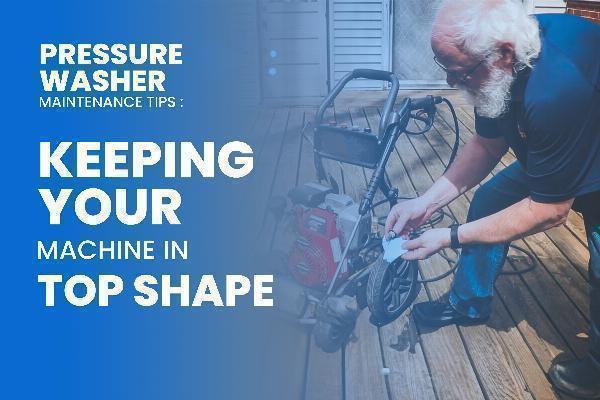Comprehensive Pressure Washer Maintenance Tips: Keeping Your Machine in Top Shape

Strong 8k brings an ultra-HD IPTV experience to your living room and your pocket.
Pressure washers are powerful tools that can tackle a wide range of cleaning tasks, from washing your car to blasting away grime from your driveway. However, like any machine, they require regular maintenance to ensure they function efficiently and have a long lifespan. In this guide, we’ll explore essential maintenance tips for keeping your pressure washer in peak condition.
Understanding Your Pressure Washer: Components and Care
Before diving into maintenance tips, it’s important to understand the key components of a pressure washer:
Engine or Motor: The power source of the pressure washer, which can be either gas-powered or electric.
Pump: The heart of the pressure washer, responsible for pressurizing the water.
Hoses and Nozzles: These components direct the high-pressure water stream onto the surface being cleaned.
Water Inlet and Outlet: The entry and exit points for water flow.
Each of these parts plays a crucial role in the operation of your pressure washer, and proper maintenance will keep them running smoothly.
1. Regularly Check and Change the Oil
Why It’s Important:
The engine or motor of your pressure washer requires oil to lubricate moving parts and prevent overheating. Regular oil changes are essential for maintaining engine efficiency and preventing damage.
How to Do It:
Check Oil Levels: Before each use, check the oil level using the dipstick. If the oil level is low or appears dirty, it’s time for a change.
Change Oil Regularly: For gas-powered models, change the oil after the first 5 hours of use and then every 50 hours or once per season. Electric models may not require oil changes, but always refer to your manufacturer’s guidelines.
Tip: Always use the type of oil recommended by the manufacturer to ensure optimal performance.
2. Inspect and Clean the Air Filter
Why It’s Important:
A clean air filter ensures that the engine receives the necessary airflow to operate efficiently. A clogged or dirty filter can restrict airflow, leading to poor performance and potential engine damage.
How to Do It:
Inspect Regularly: Check the air filter before each use. If it’s dirty or clogged, it needs to be cleaned or replaced.
Cleaning Process: If the filter is washable, clean it with warm soapy water, rinse thoroughly, and let it dry completely before reinstalling. If it’s not washable, replace it with a new one.
Tip: Keeping the air filter clean can also improve fuel efficiency in gas-powered models.
3. Maintain the Water Pump
Why It’s Important:
The pump is one of the most critical components of your pressure washer. Proper maintenance of the pump ensures consistent water pressure and prolongs the life of your machine.
How to Do It:
Use Pump Protector: After each use, especially before long-term storage, use a pump protector or antifreeze solution to lubricate and protect the pump from freezing or corrosion.
Check Seals and O-rings: Inspect the pump seals and O-rings regularly for signs of wear or damage. Replace any that are worn out to prevent leaks.
Tip: Avoid running the pressure washer without water, as this can damage the pump.
4. Clean and Inspect Hoses and Nozzles
Why It’s Important:
Hoses and nozzles are vital for directing the high-pressure water flow. Clogged or damaged nozzles can reduce water pressure, while worn hoses can lead to leaks or bursts.
How to Do It:
Check for Damage: Regularly inspect hoses for cracks, leaks, or signs of wear. Replace any damaged hoses immediately.
Clean Nozzles: Detach the nozzles from the spray wand and use a small brush or pin to clear any debris from the nozzle holes. This ensures optimal water flow and prevents blockages.
Tip: Store hoses and nozzles properly to avoid kinks and damage. Hanging them in a cool, dry place is recommended.
5. Flush the System After Use
Why It’s Important:
Flushing the system after each use helps remove any residual detergent, dirt, or debris that could clog the machine or cause damage over time.
How to Do It:
Flush with Clean Water: After using detergent, run clean water through the pressure washer for a few minutes to rinse out any remaining soap or debris.
Disconnect Hoses and Drain Water: Disconnect all hoses and allow any remaining water to drain from the machine. This prevents water from sitting in the system and causing corrosion or freeze damage.
Tip: If you’re storing the pressure washer for an extended period, consider using a pump saver to protect the internal components.
6. Store Your Pressure Washer Properly
Why It’s Important:
Proper storage is crucial for protecting your pressure washer from the elements and ensuring it’s ready for use when you need it.
How to Do It:
Choose the Right Location: Store the pressure washer in a cool, dry place, away from direct sunlight or extreme temperatures.
Drain Fluids: For gas-powered models, drain the fuel tank or add a fuel stabilizer to prevent the fuel from going stale. Electric models should be unplugged and all water drained from the system.
Cover the Machine: Use a protective cover to shield your pressure washer from dust and debris during storage.
Tip: If storing in a cold environment, make sure to use antifreeze or a pump protector to prevent freezing and damage to the pump.
7. Tighten Bolts and Screws
Why It’s Important:
Loose bolts and screws can cause the pressure washer to vibrate excessively, leading to premature wear or damage to components.
How to Do It:
Inspect Regularly: Periodically check all bolts and screws for tightness. Use the appropriate tools to tighten any that are loose.
Check Vibration Points: Pay special attention to areas that experience high vibration during operation, such as the engine or motor mounts.
Tip: Keeping bolts and screws tight not only protects your machine but also reduces noise and vibration during use.
8. Follow the Manufacturer’s Maintenance Schedule
Why It’s Important:
Each pressure washer model has specific maintenance requirements outlined by the manufacturer. Following these guidelines ensures your machine is serviced properly and maintains any warranties.
How to Do It:
Consult the Manual: Refer to the owner’s manual for recommended maintenance intervals and procedures. This includes oil changes, air filter replacements, and pump maintenance.
Keep Records: Maintain a log of all maintenance activities, including dates and details of any parts replaced. This helps you keep track of your machine’s upkeep.
Tip: Regularly updating your maintenance log can also be useful if you ever need to troubleshoot issues or sell the machine.
Conclusion
Regular maintenance is key to keeping your pressure washer running efficiently and extending its lifespan. By following these tips—checking and changing the oil, cleaning the air filter, maintaining the pump, inspecting hoses and nozzles, flushing the system, storing properly, tightening bolts, and adhering to the manufacturer’s maintenance schedule—you can ensure that your pressure washer is always ready for action. For high-quality pressure washers and maintenance supplies, visit The Blue Hose and keep your cleaning tasks on track.
Note: IndiBlogHub features both user-submitted and editorial content. We do not verify third-party contributions. Read our Disclaimer and Privacy Policyfor details.


